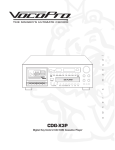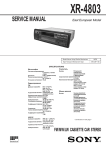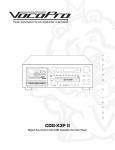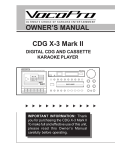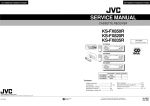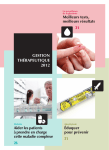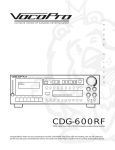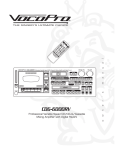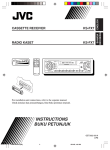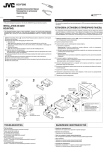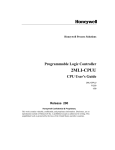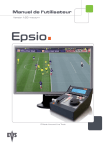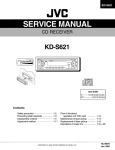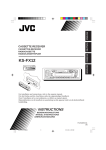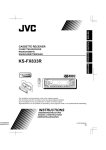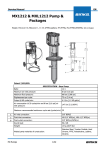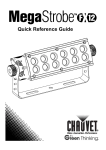Download service manual ks-fx12 ks-fx12wt ks-f150
Transcript
KS-F150 KS-FX12 SERVICE MANUAL CASSETTE RECEIVER KS-FX12 KS-FX12WT KS-F150 SYSTEM CPU LC72362N HEAD AMP UPC1228HA PLAYBACK HEAD 1-0036-7016S Area Suffix [KS-F150] J ...... Northern America Area Suffix [KS-FX12WT] J ...... Northern America Area Suffix [KS-FX12] J ...... Northern America E ... Continental Europe Contents Safety precaution ------------------------------------Instructions --------------------------------------------Disassembly method --------------------------------Adjustment method ----------------------------------Description of major ICs ----------------------------- COPYRIGHT 1-2 1-3 - 12 2-1 2-8 2-12 Block diagram ----------------------------------------Standard schematic diagrams --------------------Printed circuit boards -------------------------------Parts list ------------------------------------------------ 1999 VICTOR COMPANY OF JAPAN, LTD. 2-18 2-19 2-22 - 24 3-1 - 13 No.49522 Nov. 1999 KS-F150 KS-FX12 Safety Precaution ! CAUTION Burrs formed during molding may be left over on some parts of the chassis. Therefore, pay attention to such burrs in the case of preforming repair of this system. Feature Check List Model Features Changer Control Line Rear Output 1-2 KS-F150 J KS-FX12/FX12WT J KS-FX12 E KS-F150 KS-FX12 RECEPTOR-REPRODUCTOR DE CASSETTE KS-FX12/KS-FX12WT ESPAÑOL KS-FX12/KS-FX12WT RADIOCASSETTE FRANÇAIS CASSETTE RECEIVER ENGLISH Instructions KS-FX12/KS-FX12WT Having TROUBLE with operation? Please reset your unit Refer to page of How to reset Still having trouble?? USA ONLY Call 1-800-252-5722 http://www.jvc s e rvic e .c o m For installation and connections, refer to the separate manual. Para la instalación y las conexiones, refiérase al manual separado. Pour l’installation et les raccordements, se référer au manuel séparé. INSTRUCTIONS MANUAL DE INSTRUCCIONES MANUEL D’INSTRUCTIONS We can help you! For customer Use: Enter below the Model No. and Serial No. which are located on the top or bottom of the cabinet. Retain this information for future reference. Model No. VICTOR COMPANY OF JAPAN, LIMITED Serial No. FSUN3098-631 [J] EN, SP, FR V J C 1099HISFLEJES ENGLISH Thank you for purchasing a JVC product. Please read all instructions carefully before operation, to ensure your complete understanding and to obtain the best possible performance from the unit. CONTENTS BASIC OPERATIONS .................................................... 3 RADIO OPERATIONS ................................................... 4 Listening to the radio ..................................................................... 4 Storing stations in memory ............................................................ 5 FM station automatic preset: SSM ............................................... 5 Manual preset .............................................................................. 6 Tuning into a preset station ........................................................... 7 Other convenient tuner functions ................................................. 8 Scanning broadcast stations ....................................................... 8 Selecting FM reception sound ..................................................... 8 Changing the AM/FM channel intervals ....................................... 8 TAPE OPERATIONS ..................................................... 9 Listening to a tape .......................................................................... 9 SOUND ADJUSTMENTS ............................................. 10 Turning on/off the loudness function .......................................... 10 Selecting preset sound modes ...................................................... 10 Adjusting the sound ...................................................................... 11 Storing your own sound adjustments ......................................... 12 OTHER MAIN FUNCTIONS ......................................... 13 Setting the clock ............................................................................ 13 Detaching the control panel ......................................................... 14 CD CHANGER OPERATIONS ...................................... 15 Playing CDs ................................................................................... 15 Selecting CD playback modes ..................................................... 17 MAINTENANCE ........................................................ 18 To extend the lifetime of the unit ................................................. 18 How to reset your unit .................................................................. 18 TROUBLESHOOTING ................................................. 19 SPECIFICATIONS ....................................................... 20 2 BEFORE USE * For safety.... • Do not raise the volume level too much, as this will block outside sounds, making driving dangerous. • Stop the car before performing any complicated operations. * Temperature inside the car.... If you have parked the car for a long time in hot or cold weather, wait until the temperature in the car becomes normal before operating the unit. 1-3 KS-F150 KS-FX12 Listening to the radio Storing stations in memory 1 You can use one of the following two methods to store broadcasting stations in memory. • Automatic preset of FM stations: SSM (Strong-station Sequential Memory) • Manual preset of both FM and AM stations. FM station automatic preset: SSM 3 1 ENGLISH ENGLISH RADIO OPERATIONS 2 /I/ATT You can preset 6 local FM stations in each FM band (FM1, FM2 and FM3). Turn on the power. Note on One-Touch Operation: When you select a band in step 2 below, the power automatically comes on. You do not have to press this button to turn on the power. 2 2 FM1 FM2 FM3 FM AM Select the band (FM1, FM2, FM3 or AM). FM You can select any one of FM1, FM2, and FM3 to listen to an FM station. AM Note: When a cassette is in the cassette compartment, you cannot select the tuner. Be sure to eject the cassette from the cassette compartment to listen to the radio. 3 1 To search stations of higher frequencies. 1 FM1 FM3 Select the FM band number (FM1, FM2 or FM3) you want to store FM stations into. 2 Press and hold the button for more than 2 seconds. Start searching a station. When a station is received, searching stops. “SSM” appears, then disappears when automatic preset is over. To search stations of lower frequencies. To stop searching before a station is received, press the same button you have pressed for searching. To tune in a particular frequency manually: 4 FM2 1 Press FM or AM to select the band. 2 Press and hold T or S until “M” starts flashing on the display. Now you can manually change the frequency while “M” is flashing. T or S repeatedly until the frequency you want is reached. 3 Press • If you hold down the button, the frequency keeps changing until you release the button. Local FM stations with the strongest signals are searched and stored automatically in the band number you have selected (FM1, FM2 or FM3). These stations are preset in the number buttons — No. 1 (lowest frequency) to No. 6 (highest frequency). When automatic preset is over, the station stored in number button 1 will be automatically tuned in. Manual preset You can preset up to 6 stations in each band (FM1, FM2, FM3 and AM) manually. Example: Storing an FM station of 88.3 MHz into the preset number 1 of the FM1 band. 2 1 3 Tuning into a preset station You can easily tune into a preset station. Remember that you must store stations first. If you have not stored them yet, see page 5 or 6. 1 2 FM ENGLISH ENGLISH 5 1 Select the FM1 band. 1 FM FM1 FM2 FM3 AM 2 AM Tune into a station of 88.3 MHz. See page 4 to tune into a station. Select the band (FM1, FM2, FM3 or AM) you want. 2 3 Press and hold the button for more than 2 seconds. Select the number (1 – 6) for the preset station you want. Preset number “1” flashes for a while. 4 Repeat the above procedure to store other stations into other preset numbers. Notes: • A previously preset station is erased when a new station is stored in the same preset number. • Preset stations are erased when the power supply to the memory circuit is interrupted (for example, during battery replacement). If this occurs, preset the stations again. 6 1-4 7 KS-F150 KS-FX12 Other convenient tuner functions SEL Listening to a tape 2 MO/RND ENGLISH ENGLISH TAPE OPERATIONS 3 1 T S +/– RPT/SCAN 1 Scanning broadcast stations Turn on the power. /I/ATT When you press RPT/SCAN while listening to the radio, station scanning starts. Each time a broadcast is tuned in, scanning stops for about 5 seconds (tuned frequency number flashes on the display), and you can check what program is now being broadcast. If you want to listen to that program, press the same button again to stop scanning. 2 Insert a cassette. Selecting FM reception sound When one side of the tape reaches its end during play, the other side of the tape automatically starts playing. (Auto Reverse) When an FM stereo broadcast is hard to receive: Press MO/RND while listening to an FM stereo broadcast. The sound you hear becomes monaural but reception will be improved. Lights when receiving an FM broadcast in stereo 3 \ Select the tape direction. • Press the both buttons at the same time. Each time you press the button, the tape direction changes ) and reverse ( ). alternatively – forward ( To restore the stereo effect, press the same button again. PROG Changing the AM/FM channel intervals When using this unit in an area other than North or South America: When this unit is shipped from the factory, the channel intervals are set to 10 kHz for AM and 200 kHz for FM. You can change the channel intervals by following the procedure below. 1 Press SEL (select) for more than 2 seconds. “CLOCK H,” “CLOCK M” or “AREA” appears on the display. T or S until it appears. 2 If “AREA” does not appear, press 3 Press +. “AREA EU” appears and the channel intervals are set to 9 kHz for AM and 50 kHz (for manual tuning) / 100 kHz (for searching) for FM. To reset to the factory setting, follow the above step 1 and 2, then press – in step 3 (“AREA US” appears on the display.) To stop play and eject the cassette Press 0. Tape play stops and the cassette ejects from the cassette compartment. You can hear the last received station. • You can also eject the cassette with the unit turnd off. To fast-wind a tape Press either ¡ or 1. The tape will be wound in the direction of the arrows (¡ or 1). To restart playback, press ¡ or 1 lightly. Tape direction AREA EU: Select this when used in an area other than North and South America. AREA US: Select this when used in North or South America. 8 9 Turning on/off the loudness function Adjusting the sound The human ear is less sensitive to low and high frequencies at low volumes. The loudness function can boost these frequencies to produce a well-balanced sound at low volume levels. Each time you press LOUD, the loudness function turns on/off alternatively. ENGLISH ENGLISH SOUND ADJUSTMENTS You can adjust the treble/bass sound and the speaker balance. LOUD |\ 2 Selecting preset sound modes 1 1 Select the item you want to adjust. You can select a preset sound adjustment suitable to the music genre. Each time you press SOUND, the sound mode changes as follows. SOUND Indication Indication For: Preset values Bass Treble Loudness SCM OFF (Flat sound) 00 00 On BEAT Rock or disco music +2 00 On POP Light music +4 +1 Off SOFT Quiet background music +1 –3 Off Notes: • You can adjust the preset sound mode to your preference, and store it in memory. If you want to adjust and store your original sound mode, see “Storing your own sound adjustments” on page 12. • To adjust only the bass and treble reinforcement levels to your preference, see “Adjusting the sound” on page 11. • When one of the sound modes is selected, it is shown on the display as follows: To do: Range BAS (bass) Adjust the bass –6 (min.) — +6 (max.) TRE (treble) Adjust the treble –6 (min.) — +6 (max.) FAD (Fader)* Adjust the front and rear speaker balance R6 (rear only) — F6 (front only) BAL (Balance) Adjust the left and right speaker balance L6 (left only) — R6 (right only) VOL (Volume) Adjust the volume 00 (min.) — 50 (max.) Note: * If you are using a two-speaker system, set the fader level to “00”. 2 Adjust the level. Note: Normally the + and – buttons work as the volume control buttons. So you do not have to select “VOL” to adjust the volume level. For example, when “POP” is selected. 10 11 1-5 KS-F150 KS-FX12 Storing your own sound adjustments Setting the clock ENGLISH ENGLISH OTHER MAIN FUNCTIONS You can adjust the sound modes (BEAT, POP, SOFT: see page 10) to your preference and store your own adjustments in memory. 2,3 3 1 2 2 1,4 1 2,3 1 Press and hold the button for more than 2 seconds. SOUND “CLOCK H,” “CLOCK M” or “AREA” appears on the display. Call up the sound mode you want to adjust. Within 5 seconds 2 See page 10 for details. 2 1. Set the hour. 1. Select “CLOCK H” if not shown on the display. To adjust the bass or treble sound level Select “BAS” or “TRE.” LOUD 2. To turn on or off the loudness function Within 5 seconds 3 4 Each time you press LOUD, the loudness function turns on and off alternatively. (= go to step 4) 2. Adjust the hour. 3 1. Set the minute. 1. Select “CLOCK M.” Adjust the bass or treble level. See page 11 for details. 2. 2. Adjust the minute. Within 5 seconds 4 SOUND Press and hold SOUND until the sound mode you have selected in step 1 flashes on the display. Your setting is stored in memory. 5 4 Start the clock. To check the current clock time (changing the display mode) Press DISP repeatedly. Each time you press the button, the display mode changes as follows. During tape operation: During tuner operation: Repeat the same procedure to store other settings. Clo c k Fre que nc y Play m o d e During CD operation: Elap s e d p lay ing tim e Clo c k To reset to the factory settings Clo c k Repeat the same procedure and reassign the preset values listed in the table on page 10. 12 13 Detaching the control panel You can detach the control panel when leaving the car. When detaching or attaching the control panel, be careful not to damage the connectors on the back of the control panel and on the panel holder. How to detach the control panel Before detaching the control panel, be sure to turn off the power. 1 2 How to attach the control panel 1 Unlock the control panel. 2 Lift and pull the control panel out of the unit. Insert the left side of the control panel into the groove on the panel holder. Before operating your CD automatic changer: • Refer also to the Instructions supplied with your CD changer. • If no discs are in the magazine of the CD changer or the discs are inserted upside down, “NO CD” or “NO DISC” will appear on the display. If this happens, remove the magazine and set the discs correctly. • If “RESET 1 - RESET 8” appears on the display, something is wrong with the connection between this unit and the CD changer. If this happens, check the connection, connect the connecting cord(s) firmly if necessary, then press the reset button of the CD changer. ENGLISH ENGLISH CD CHANGER OPERATIONS We recommend that you use one of the CH-X series with your unit. If you have another CD automatic changer, consult your JVC car audio dealer for connections. • For example, if your CD automatic changer is one of the KD-MK series, you need a cord (KSU15K) for connecting it to this unit. Playing CDs Press the right side of the control panel to fix it to the panel holder. ¢ 4 1 Number buttons 1 Select the CD automatic changer. CD-CH Playback starts from the first track of the first disc. All tracks of all discs are played back. 3 Put the detached control panel into the provided case. Note on cleaning the connectors: If you frequently detach the control panel, the connectors will deteriorate. To minimize this possibility, periodically wipe the connectors with a cotton swab or cloth moistened with alcohol, being careful not to damage the connectors. Disc number \ Track number Elapsed playing time (The clock time is shown if you have pressed DISP to see the clock time. See page 13.) Note on One-Touch Operation: When you press CD-CH, the power automatically comes on. You do not have to press to turn on the power. Connectors 14 1-6 15 KS-F150 KS-FX12 Selecting CD playback m odes ENGLISH ENGLISH To fast forward or reverse the track ¢, while playing a CD, to fast forward the track. Press and hold Press and hold 4 , while playing a CD, to reverse the track. To go to the next track or the previous track MO/RND Press ¢ briefly, while playing a CD, to go ahead to the beginning of the next track. Each time you press the button consecutively, the beginning of the next tracks is located and played back. briefly, while playing a CD, to go back to the beginning Press 4 of the current track. Each time you press the button consecutively, the beginning of the previous tracks is located and played back. RPT/SCAN To play back tracks at random (Random Play) MO/RND Each time you press MO/RND (Mono/Random) while playing a CD, CD random play mode changes as follows: RND1 RND2 (Random1) (Random2) Canceled To go to a particular disc directly 7 8 9 10 11 12 Press the number button corresponding to the disc number to start its playback. • To select a disc number from 1 – 6: Press 1 (7) – 6 (12) briefly. • To select a disc number from 7 – 12: Press and hold 1 (7) – 6 (12) for more than 1 second. Mode RND Indicator Plays at random RND1 Lights All tracks of the current disc, then the tracks of the next disc, and so on. RND2 Flashes All tracks of all discs inserted in the magazine. To play back tracks repeatedly (Repeat Play) RPT SCAN Each time you press RPT/SCAN (Repeat/Scan) while playing a CD, CD repeat play mode changes as follows: RPT1 RPT2 (Repeat1) (Repeat2) Canceled Ex. When disc number 3 is selected Mode Disc number RPT Indicator Plays repeatedly RPT1 Lights The current track (or specified track). RPT2 Flashes All tracks of the current disc (or specified disc). Track number 16 17 To extend the lifetime of the unit This unit requires very little attention, but you will be able to extend the life of the unit if you follow the instructions below. To clean the heads • Clean the heads after every 10 hours of use using a wet-type head cleaning tape (available at an audio store). When the head becomes dirty, you may realize the following symptoms: – Sound quality is reduced. – Sound level decreases. – Sound drops out. • Do not play dirty or dusty tapes. • Do not touch the highly-polished head with any metallic or magnetic tools. TROUBLESHOOTING What appears to be trouble is not always serious. Check the following points before calling a service center. Symptoms You have tried to insert a cassette in the wrong way. • Cassette tapes become hot. This is not a malfunction. • Tape sound is at very low level and sound quality is degraded. The tape head is dirty. Clean it with a head cleaning tape. • Sound is sometimes interrupted. Connections are not good. Check the cords and connections. • Sound cannot be heard from the speakers. The volume control is turned to the minimum level. Adjust it to the optimum level. Connections are incorrect. Check the cords and connections. • Static noise while listening to the radio. The antenna is not connected firmly. Connect the antenna firmly. • “NO CD” or “NO DISC” appears on the display. No CD is in the magazine. Insert CDs into the magazine. CDs are inserted incorrectly. Insert them correctly. This unit is not connected to a CD changer correctly. Connect this unit and the CD changer correctly and press the reset button of the CD changer. • “RESET 8” appears on the display. CAUTIONS: • Do not play the tapes with peeling labels; otherwise, they can damage the unit. • Tighten tapes to remove slack since loose tape may become entangled with the mechanism. • Do not leave a cassette in the cassette compartment after use, as the tape may become slack. How to reset your unit Press and hold both the SEL (Select) and (Standby/On/ATT) buttons at the same time for several seconds. This will reset the built-in microcomputer. NOTE: Your preset adjustments — such as preset channels or sound adjustments — will also be erased. Remedies Insert the cassette with the • A cassette tape cannot be inserted. To keep the tape clean • Always store the tapes to their storage cases after use. • Do not store tapes in the following places: – Subject to direct sunlight – With high humidity – At extremely hot temperatures Causes • “RESET 1-RESET 7” appears on the display. • The unit does not work at all. ENGLISH ENGLISH MAINTENANCE exposed tape facing right. Press the reset button of the CD changer. The built-in microcomputer may function incorrectly due to noise, etc. While holding SEL, press for more than 2 seconds to reset the unit. (The clock setting and preset stations stored in memory are erased.) (See page 18). (Standby/On/ATT) SEL (Select) 18 19 1-7 KS-F150 KS-FX12 ENGLISH SPECIFICATIONS AUDIO AMPLIFIER SECTION CASSETTE DECK SECTION Maximum Power Output: Front: 40 watts per channel Rear: 40 watts per channel Continuous Power Output (RMS): Front: 16 watts per channel into 4 Ω, 40 to 20,000 Hz at no more than 0.8% total harmonic distortion. Rear: 16 watts per channel into 4 Ω, 40 to 20,000 Hz at no more than 0.8% total harmonic distortion. Load Impedance: 4 Ω (4 to 8 Ω allowance) Tone Control Range Bass: ±10 dB at 100 Hz Treble:±10 dB at 10 kHz Frequency Response: 40 to 20,000 Hz Signal-to-Noise Ratio: 70 dB Wow & Flutter: 0.15% (WRMS) Fast-Wind Time: 190 sec. (C-60) Frequency Response: 50 to 14,000 Hz (±3 dB) Signal-to-Noise Ratio: 52 dB Stereo Separation: 40 dB TUNER SECTION Frequency Range FM: 87.5 to 107.9 MHz (with channel interval set to 200 kHz) 87.5 to 108.0 MHz (with channel interval set to 50 kHz) AM: 530 to 1,710 kHz (with channel interval set to 10 kHz) 531 to 1,602 kHz (with channel interval set to 9 kHz) [FM Tuner] Usable Sensitivity: 11.3 dBf (1.0 µV/75 Ω) 50 dB Quieting Sensitivity: 16.3 dBf (1.8 µV/75 Ω) Alternate Channel Selectivity (400 kHz): 65 dB Frequency Response: 40 to 15,000 Hz Stereo Separation: 35 dB Capture Ratio: 2.0 dB [AM Tuner] Sensitivity: 20 µV Selectivity: 35 dB 20 1-8 GENERAL Power Requirement Operating Voltage: DC 14.4 volts (11 to 16 volts allowance) Grounding System: Negative ground Dimensions (W x H x D) Installation Size: 182 x 52 x 150 mm (7-3/16" x 2-1/16" x 5-15/16") Panel Size: 188 x 58 x 14 mm (7-7/16" x 2-5/16" x 5/8") Mass: 1.3 kg (2.9 lbs) (excluding accessories) Design and specifications subject to change without notice. If a kit is necessary for your car, consult your telephone directory for the nearest car audio speciality shop. KS-F150 KS-FX12 KS -FX12 KS -FX12W T Installation/Connection Manual Manual de instalación/conexión Manuel d’installation/raccordement FSUN3098-T631 [J] V J ENGLIS H ES PAÑOL C 1099HISFLEJES EN, SP, FR FRANÇAIS • This unit is designed to operate on 12 volts DC, NEGATIVE ground electrical systems. • Esta unidad está diseñada para funcionar con 12 voltios de CC, con sistemas eléctricos de masa NEGATIVA. • Cet appareil est conçu pour fonctionner sur des sources de courant continu de 12 volts à masse NEGATIVE. INSTALLATION (IN-DASH MOUNTING) INSTALACION (MONTAJE EN EL TABLERO DE INSTRUMENTOS) INSTALLATION (MONTAGE DANS LE TABLEAU DE BORD) • The following illustration shows a typical installation. However, you should make adjustments corresponding to your specific car. If you have any questions or require information regarding installation kits, consult your JVC car audio dealer or a company supplying kits. • La siguiente ilustración muestra una instalación típica. Sin embargo usted deberá efectuar los ajustes correspondientes a su automóvil. Si tiene alguna pregunta o necesita información acerca de las herramientas para instalación, consulte con su concesionario de JVC de equipos de audio para automóviles o a una compañía que suministra tales herramientas. • L’illustration suivante est un exemple d’installation typique. Cependant, vous devez faire les ajustements correspondant à votre voiture particulière. Si vous avez des questions ou avez besoin d’information sur des kits d’installation, consulter votre revendeur d’autoradios JVC ou une compagnie d’approvisionnement. 1 Be fo re mo unting : Press (Control Panel Release button) to detach the control panel. 1 Ante s de ins talar: Presione (botón de liberación del panel de control) para desmontar el panel de control. 2 3 Remove the trim plate. 2 3 Retire la placa de guarnición. Remove the sleeve after disengaging the sleeve locks. 1 Stand the unit. Avant le mo ntag e : Appuyer sur (touche de libération du panneau de commande) pour détacher le panneau de commande. 2 3 Retirer la plaque d’assemblage. Re marque : Lorsque vous mettez l’appareil à la verticale, faire attention de ne pas endommager le fusible situé sur le fond. No ta: Al poner la unidad vertical, tenga cuidado de no dañar el fusible provisto en la parte posterior. 2 Inserte las dos asas entre la unidad y la cubierta tal como en la ilustración y desenganche los retenes de la cubierta. 3 Retire la cubierta. No te : Be sure to keep the handles for future use after installing the unit. 2 Insérer les 2 poignées entre l’appareil et le manchon comme indiqué pour désengagé les verrous de manchon. 3 Retirer le manchon. No ta: Después de instalar la unidad, asegúrese de guardar las asas para uso futuro. Install the sleeve in the dashboard. * After the sleeve is correctly installed in the dashboard, bend the appropriate tabs to hold the sleeve firmly in place, as illustrated. 5 Fix the mounting bolt to the rear of the unit’s body and place the rubber cushion over the end of the bolt. 6 Do the required electrical connections explained on the back of this instructions. 7 8 9 Slide the unit into the sleeve until it is locked. Attach the trim plate. 4 Instale la cubierta en el tablero de instrumentos. Re marque : S'assurer de garder les poignées pour une utilisation ultérieur, après l'installation de l'appareil. 4 * Después de que la cubierta esté correctamente instalada en el tablero de instrumentos, doble las lengüetas correspondientes para sostener la cubierta firmemente en su lugar, tal como se muestra. 5 Fixe el perno de montaje ou la parte trasera del cuerpo de la unidad y coloque el cojín de goma sobre el extremo del perno. 6 Realice las conexiones eléctricas requeridas en base a las explicaciones que figuran en la parte de atrás de estas instrucciones. 7 Deslice la unidad dentro de la cubierta hasta que quede trabada. 8 9 Coloque la placa de guarnición. Attach the control panel. Libérer les verrous du manchon et retirer le manchon. 1 Poser l’appareil à la verticale. 1 Ponga la unidad vertical. No te : When you stand the unit, be careful not to damage the fuse on the rear. 2 Insert the 2 handles between the unit and the sleeve, as illustrated, to disengage the sleeve locks. 3 Remove the sleeve. 4 Retire la cubierta después de desenganchar los retenes de la cubierta. 1 Installer le manchon dans le tableau de bord. * Après installation correcte du manchon dans le tableau de bord, plier les bonnes pattes pour maintenir fermement le manchon en place, comme montré. 5 Monter le boulon de montage sur l’arrière du corps de l’appareil puis passer l’amortisseur en caoutchouc sur l’extrémité du boulon. 6 Réalisez les connexions électriques expliquées au dos de cette page. 7 Faire glisser l’appareil dans le manchon jusqu’à ce qu’il soit verrouillé. 8 9 Fixer la plaque d’assemblage. Remonter le panneau de commande. Coloque el panel de control. 2 1 Dashboard Tablero de instrumentos Tableau de bord Rubber cushion Cojín de goma Amortisseur en caoutchouc Multi Mus ic Scan Sleeve Cubierta Manchon 4 7 3 9 Handle Manija Poignée 53 mm 5 Mounting bolt Perno de montaje Boulon de montage 4* 8 18 4m m 6 See the back page for electrical connections. Con respecto a las conexiones eléctricas, consulte la página de atrás. Voir le dos de cette page pour les connexions électriques. Mult Mus i Scaic n 10 Trim plate Placa de guarnición Plaque d’assemblage 2 3 1 1 2 3 5 10 Sleeve Cubierta Manchon Fuse Fusible Fusible Slot Ranura Fente 4 Lock plate Placa de bloqueo Plaque de verrouillage 1-9 KS-F150 KS-FX12 • When installing the unit without using the sleeve • Instalación de la unidad sin utilizar la cubierta • Lors de l'installation de l’appareil sans utiliser de manchon • When using the optional stay • Cuando emplea un soporte opcional • Lors de l'utilisation du hauban en option In a Toyota for example, first remove the car radio and install the unit in its place. En un Toyota por ejemplo, primero extraiga la radio del automóvil y luego instale la unidad en su lugar. Par exemple dans une Toyota, retirer d’abord l’autoradio et installer l’appareil à la place. Fire wall Tabique a prueba de incendios Cloison * Not included with this unit. * No suministrado con esta unidad. * Non fourni avec cet appareil. Flat type screws (M5 x 6 mm)* Tornillos tipo plano (M5 x 6 mm)* Vis à tête plate (M5 x 6 mm)* Dashboard Tablero de instrumentos Tableau de bord Stay (option) Soporte (opción) Hauban(en option) Washer Arandela Rondelle Lock nut Tuerca de seguridad Ecrou d’arrêt Screw (option) Tornillo (opción) Vis (en option) Mounting bolt Perno de montaje Boulon de montage Bracket* Ménsula* Support* Mult Mus i ic Scan Flat type screws (M5 x 6 mm)* Tornillos tipo plano (M5 x 6 mm)* Vis à tête plate (M5 x 6 mm)* Pocket Compartimiento Poche Bracket* Ménsula* Support* Sleeve Cubierta Manchon No te : When installing the unit on the mounting bracket, make sure to use the 6 mm-long screws. If longer screws are used, they could damage the unit. No ta: Cuando instala la unidad en la ménsula de montaje, asegúrese de utilizar los tornillos de 6 mm de longitud. Si se utilizan tornillos más largos, éstos pueden dañar la unidad. Re marque : Lors de l'installation de l’appareil sur le support de montage, s’assurer d’utiliser des vis d’une longueur de 6 mm. Si des vis plus longues sont utilisées, elles peuvent endommager l’appareil. Removing the unit Extracción de la unidad Retrait de l’appareil • Before removing the unit, release the rear section. • Antes de extraer la unidad, libere la sección trasera. • Avant de retirer l’appareil, libérer la section arrière. 1 1 Extraiga el panel de control. 1 Retirer le panneau de commande. Retire la placa de guarnición. 2 Retirer la plaque d’assemblage. 3 Introduire les deux poignées dans les fentes, comme montré. Puis, tout en tirant doucement les poignées écartées, faire glisser l’appareil pour le sortir. (S 'as s ure r de c o ns e rv e r le s po ig née s après l’ins tallatio n de l’appare il.) 2 3 Remove the control panel. Remove the trim plate. Insert the 2 handles into the slots, as shown. Then, while gently pulling the handles away from each other, slide out the unit. (Be s ure to ke e p the handle s afte r ins talling it.) 1 2 3 Inserte las 2 manijas entre las ranuras, como se muestra. Luego, separe gentilmente las manijas y extraiga la unidad. (As e g úre s e d e c o n s e rv a r la s m a n ija s d e s p u és d e ins talarlo .) 3 2 Handle Manija Poignée Mult Mus i ic Scan Parts list for installation and connection Lista de piezas para instalación y conexión The following parts are provided with this unit. After checking them, please set them correctly. Con esta unidad se suministran las siguientes piezas. Después de inspeccionarlas, colóquelas correctamente. Hard case Estuche duro Etui de transport Power cord Cordón de alimentación Cordon d’alimentation Liste des pièces pour l’installation et raccordement Les pièces suivantes sont fournies avec cet appareil. Après vérification, veuillez les placer correctement. Lock nut (M5) Tuerca de seguridad (M5) Ecrou d’arrêt (M5) Trim plate Placa de guarnición Plaque d’assemblage Handles Manijas Poignées Sleeve Cubierta Manchon Washer (ø5) Arandela (ø5) Rondelle (ø5) Rubber cushion Cojín de goma Amortisseur en caoutchouc 1-10 Mounting bolt (M5 x 20 mm) Perno de montaje (M5 x 20 mm) Boulon de montage (M5 x 20 mm) KS-F150 KS-FX12 ENGLIS H ES PAÑOL FRANÇAIS ELECTRICAL CONNECTIONS CONEXIONES ELECTRICAS RACCORDEMENTS ELECTRIQUES To prevent short circuits, we recommend that you disconnect the battery’s negative terminal and make all electrical connections before installing the unit. If you are not sure how to install this unit correctly, have it installed by a qualified technician. Para evitar cortocircuitos, recomendamos que desconecte el terminal negativo de la batería y que efectúe todas las conexiones eléctricas antes de instalar la unidad. Si usted no está seguro de cómo instalar correctamente la unidad, hágala instalar por un técnico cualificado. Pour éviter tout court-circuit, nous vous recommandons de débrancher la borne négative de la batterie et d’effectuer tous les raccordements électriques avant d’installer l’appareil. Si l'on n’est pas sûr de pouvoir installer correctement cet appareil, le faire installer par un technicien qualifié. No ta: Esta unidad está diseñada para funcionar con 12 v o ltio s de CC, c o n s is te mas e léc tric o s de mas a NEGATIVA. Si su vehículo no posee este sistema, será necesario un inversor de tensión, que puede ser adquirido en los concesionarios de JVC de equipos de audio para automóviles. • Reemplace el fusible por uno con la corriente especificada. Si el fusible se quemase frecuentemente consulte con su concesionario de JVC de equipos de audio para automóviles. • Si el ruido fuese un problema... Esta unidad tiene un filtro de ruido en el circuito de alimentación. Sin embargo, en algunos vehículos, pueden producirse chasquidos u otros ruidos indeseados. En tal caso conecte el te rminal de tie rra po s te rio r (Ver diagrama de conexión abajo.) del receptor al chasis del automóvil, utilizando cordones más gruesos y cortos tales como alambre de cobre trenzado o de grueso calibre. Si el ruido persiste, consulte a su concesionario de JVC de equipos de audio para automóvil. • La entrada máxima de los altavoces traseros debe ser mayor de 40 vatios y la de los delanteros de 40 vatios, con una impedancia de 4 a 8 o hmnio s . • As e g úre s e de c o ne c tar e s ta unidad a tie rra e n e l c has is de l auto móv il. • El sumidero térmico estará muy caliente después del uso. Asegúrese de no tocarlo al desmontar esta unidad. Re marque : Cet appareil est conçu pour fonctionner sur des sources de courant continu de 12 vo lts à mas s e NEGATIVE. Si votre véhicule n’offre pas ce type d’alimentation, il vous faut un convertisseur de tension, que vous pouvez acheter chez un revendeur d’autoradios JVC. • Remplacer le fusible par un de la valeur précisée. Si le fusible saute souvent, consulter votre revendeur d’autoradios JVC. • Si le bruit est un problème... Cet appareil incorpore un filtre de bruit dans le circuit d’alimentation. Cependant, avec certains véhicules, quelques claquements ou autres bruits non désirés risquent de se produire. Si cela arrive, raccorder la bo rne de mas s e arrière de l’appareil au châssis de la voiture (voir le schéma de raccordement cidessous) en utilisant des cordons les plus gros et les plus courts possibles telle qu'une barre de cuivre ou une tresse. Si le bruit persiste, consulter votre revendeur d’autoradios JVC. • La puissance admissible des haut-parleurs doit être supérieure à 40 watts à l’arrière et à 40 watts l’avant, avec une impédance de 4 à 8 o hms . • S 'as s ure r de rac c o rde r la mis e à la mas s e de c e t appare il au c hâs s is de la v o iture . • Le radiateur devient très chaud après usage. Faire attention de ne pas le toucher en retirant cet appareil. No te : This unit is designed to operate on 12 vo lts DC, NEGATIVE g ro und e le c tric al s ys te ms . If your vehicle does not have this system, a voltage inverter is required, which can be purchased at JVC car audio dealers. • Replace the fuse with one of the specified rating. If the fuse blows frequently, consult your JVC car audio dealer. • If noise is a problem... This unit incorporates a noise filter in the power circuit. However, with some vehicles, clicking or other unwanted noise may occur. If this happens, connect the unit’s re ar g ro und te rminal (See connection diagram below.) to the car’s chassis using shorter and thicker cords, such as copper braiding or gauge wire. If noise still persists, consult your JVC car audio dealer. • Maximum input of the speakers should be more than 40 watts at the rear and 40 watts at the front, with an impedance of 4 to 8 o hms . • Be s ure to g ro und this unit to the c ar’s chas s is . • The heat sink becomes very hot after use. Be careful not to touch it when removing this unit. Heat sink Sumidero térmico Dissipateur de chaleur A Typical Connections / Conexiones típicas / Raccordements typiques Be fo re c o nne c ting : Check the wiring in the vehicle carefully. Incorrect connection may cause serious damage to this unit. 1 2 3 Connect the colored leads of the power cord to the car battery, speakers and automatic antenna (if any) in the following sequence. 1 Black: ground 2 Yellow: to car battery (constant 12V) 3 Red: to an accessory terminal 4 Others (except blue with white stripe): to speakers 5 Blue with white stripe: to automatic antenna (200mA max.) Connect the antenna cord. Finally connect the wiring harness to the unit. Ante s de la c o nex ión: Verifique atentamente el conexionado del vehículo. Una conexión incorrecta podría producir daños graves en la unidad. Avant de c o mme nc e r la c o nnex io n: vérifiez attentivement le câblage du véhicule. Une connexion incorrecte peut endommager sérieusement l’appareil. 1 Conecte los conductores de color del cable de alimentación a la batería del automóvil, altavoces y antena automática (si la hubiere) en la secuencia siguiente. 1 Negro: a tierra. 2 Amarillo: a la batería del autom óvil (12V constantes) 3 Rojo: a un terminal de accesorio 4 Otros, excepto azul con rayas blancas: a los altavoces 5 Azul con rayas blancas: a la antena automática (200mA máx.) 1 2 3 Conecte el cable de antena. Connectez les fils de couleur du cordon d’alimentation à la batterie de la voiture, aux enceintes et à l’antenne automatique (s’il y en a une) dans l’ordre suivant. 1 Noir: a la masse 2 Jaune: a la batterie de la voiture (12V constant) 3 Rouge: à la prise accessoire 4 Autres fils à l’exception du fil bleu à bandes blanches: aux enceintes 5 Bleu à bandes blanches: à l’antenne automatique (200mA max.) 2 3 Connectez le cordon d’antenne. Por último, conecte a la unidad el cableado preformado. We recommend that you connect one of the CH-X series CD changers. • If your CD changer is one of the KD-MK series, you need an optional cord (KS-U15K). Recomendamos conectar uno de los cambiadores de CD de la serie CH-X. • Si su cambiador de CD es de la serie KD-MK, necesitará un cable opcional (KS-U15K). Nous recommandons que vous connectiez un changeur de CD de la série CH-X. • Si votre changeur de CD appartient à la série KD-MK, vous avez besoin d’un cordon optionnel (KS-U15K). JVC CD changer jack Jack del cambiador de CD de JVC Prise de changeur CD JVC JVC CD changer cambiador de CD de JVC changeur de CD JVC Antenna terminal Terminal de la antena Borne de l’antenne 10 Rear ground terminal Terminal de tierra posterior Borne arrière de masse 10A fuse Fusible de 10A Fusible 10A Black Negro Noire 3 2 To antenna A la antena A l'antenne 1 1 Yellow*1 Amarillo*1 Jaune*1 *1: Before checking the operation of this unit prior to installation, this lead must be connected, otherwise power cannot be turned on. *1: Antes de comprobar el funcionamiento de esta unidad previa a de la instalación, es necesario conectar este cable, de lo contrario no se podrá conectar la alimentación. *1: Pour vérifier le fonctionnement de cet appareil avant installation, ce fil doit être raccordé, sinon l’appareil ne peut pas être mis sous tension. Red Rojo Rouge 2 White Blanco Blanc Gray with black stripe Gris con rayas negras Gris avec bande noire Left speaker (front) Altavoz izquierdo (frontal) Haut-parleur gauche (avant) Gray Gris Gris Ignition switch Interruptor de encendido Interrupteur d'allumage included with this unit. * Not No suministrado con esta unidad. Non fourni avec cet appareil. * To metallic body or chassis of the car A un cuerpo metálico o chasis del automóvil Vers corps métallique ou châssis du véhicule * To a live terminal in the fuse block connecting to the car battery (bypassing the ignition swich). A un terminal activo del bloque de fusibles conectado a la batería del automóvil (desviando el interruptor de encendido) A une borne sous tension du porte-fusible connectée à la batterie de la voiture (en dérivant l’interrupteur d’allumage) Blue with white stripe Azul con rayas blancas Bleu avec bande blanche 4 White with black stripe Blanco con rayas negras Blanc avec bande noire Finalement, connectez le faisceau de fils à l’appareil. 3 Fuse block Bloque de fusibles Porte-fusible To an accessory terminal in the fuse block A un terminal accesorio del bloque de fusibles Vers borne accessoire du porte-fusible Green with black stripe Verde con rayas negras Vert avec bande noire Right speaker (front) Altavoz derecho (frontal) Haut-parleur droit (avant) 5 Green Verde Vert To automatic antenna if any A la antena automática si la hubiere Vers borne d’antenne automatique s'il y en a une Purple with black stripe Púrpura con rayas negras Violet avec bande noire Left speaker (rear) Altavoz izquierdo (trasero) Haut-parleur gauche (arrière) Purple Púrpura Violet Right speaker (rear) Altavoz derecho (trasero) Haut-parleur droit (arrière) 1-11 KS-F150 KS-FX12 PRECAUTIONS on power supply and speaker connections: • DO NOT c o nne c t the s pe ake r le ads o f the powe r c o rd to the c ar batte ry; o the rwis e , the unit will be s e rio us ly damag e d. • Connect the black lead (ground), yellow lead (to car battery, constant 12V), and red lead (to an accessory terminal) correctly. • BEFORE connecting the speaker leads of the power cord to the speakers, check the speaker wiring in your car. – If the s pe ake r wiring in yo ur c ar is as illus trate d in Fig . 1 and Fig . 2 be low, DO NOT connect the unit using that original speaker wiring. If you do, the unit will be seriously damaged. Redo the speaker wiring so that you can connect the unit to the speakers as illustrated in Fig. 3. – If the s pe ake r wiring in yo ur c ar is as illus trate d in Fig . 3, you can connect the unit using the original speaker wiring in your car. – If you are not sure of the speaker wiring of your car, consult your car dealer. + L - + R - PRECAUCIONES sobre las conexiones de la fuente de alimentación y de los altavoces: PRECAUTIONS sur l’alimentation et la connexion des enceintes: • NO c o ne c te lo s c o nduc to re s de altav o z de l c able de alime ntac ión a la bate ría de auto móv il, pue s po drían pro duc irs e g rav e s daño s e n la unidad. • Conecte correctamente el conductor negro (a tierra), el conductor amarillo (a la batería del automóvil, 12V constantes), y el conductor rojo (a un terminal de accesorio). • ANTES de conectar a los altavoces los conductores de altavoz del cable de alimentación, verifique el conexionado de altavoz de su automóvil. – S i e l c o nex io nado de altavo z de s u auto móv il e s c o mo s e indic a e n las Fig s . 1 y 2 de abajo , NO conecte la unidad utilizando ese conexionado de altavoz original. Si lo hace, se producirán daños graves en la unidad. Vuelva a efectuar el conexionado de altavoz de manera que pueda conectar la unidad a los altavoces de la manera indicada en la Fig.3. – S i e l c o nex io nado de altavo z de s u auto móv il e s c o mo s e indic a e n la Fig .3, podrá conectar la unidad utilizando el conexionado de altavoz original de su automóvil. – Si tiene dudas sobre el conexionado de altavoz de su automóvil, consulte con su concesionario. • NE CONNECTEZ PAS le s fils d’e nc e inte s du c o rdo n d ’a lim e n ta tio n à la ba tte rie ; s in o n , l’a p p a re il s e ra it s érie us e me nt e ndo mmag é. • Connectez correctement le fil noir (a la masse), le fil jaune (a la batterie de la voiture,12V constant) et le fil rouge (à la prise accessoire). • AVANT de connecter les fils d’enceintes du cordon d’alimentation aux enceintes, vérifiez le câblage des enceintes de votre voiture. – S i le c âblag e de s e nc e inte s de vo tre vo iture e s t réalis é c o mme mo ntré s ur la Fig . 1 o u Fig . 2 c i-de s s o us , NE CONNECTEZ PAS l’appareil en utilisant ce câblage original d’enceintes. Si vous le faites, l’appareil sera sérieusement endommagé. Recommencez le câblage des enceintes de façon que vous puissiez connecter l’appareil aux enceintes comme montré sur la Fig. 3. – S i le c âblag e de s e nc e inte s de vo tre vo iture e s t c o mme mo ntré s ur la Fig . 3, vous pouvez connecter l’appareil en utilisant ce câblage original d’enceintes pour votre voiture. – Si vous n’êtes pas sûrs du câblage d’enceintes de votre voiture, consulter le concessionnaire de votre voiture. + + L - - + + R - - Fig . 1 + + L - - + + R - - Fig . 2 + - + - Fig . 3 Co nne c ting the le ads / Co ne x ión de lo s c o nduc to re s / Rac c o rde me nt de s fils Twist the core wires when connecting. Retuerza los alambres de alma para conectarlos. Torsader les âmes des fils en les raccordant. Solder the core wires to connect them securely. Suelde los alambres de alma para conectarlos con firmeza. Souder les âmes desfils pour les raccorder entre eux de façon sûre. TROUBLESHOOTING • The fus e blo ws . * Are the red and black leads connected correctly? • To prev e nt s ho rt-c irc uit, c ov e r the te rminals o f the UNUS ED le ads with ins ulating tape . • Para e v itar c o rto c irc uito s , c ubra lo s c able s NO UTILIZADOS c o n c inta ais lante . • Po ur év ite r le s c o urt-c irc uits , c o uv rir le s bo rne s de s fils qui ne s o nt PAS utilis és av e c de la bande is o lante LOCALIZACION DE AVERIAS EN CAS DE DIFFICULTÉS • El fus ible s e que ma. * ¿Están los conductores rojo y negro correctamente conectados? • Le fus ible s aute . * Les fils rouge et noir sont-ils racordés correctement? • Po we r c anno t be turne d o n. * Is the yellow lead connected? • No e s po s ible c o ne c tar la alime ntac ión. * ¿Está el cable amarillo conectado? • L’appare il ne pe ut pas être mis e s o us te ns io n. * Le fil jaune est-elle raccordée? • No s o und fro m the s pe ake rs . * Is the speaker output lead short-circuited? • No s ale s o nido de lo s altav o c e s . * ¿Está el cable de salida del altavoz cortocircuitado? • Pas de s o n de s haut-parle urs . * Le fil de sortie de haut-parleur est-il court-circuité? • S o und is dis to rte d. * Is the speaker output lead grounded? * Are the “–” terminals of L and R speakers grounded in common? • El s o nido pre s e nta dis to rs ión. * ¿Está el cable de salida del altavoz conectado a masa? * ¿Están los terminales “–” de los altavoces L y R conectados a una masa común? • Le s o n e s t défo rmé. * Le fil de sortie de haut-parleur est-il à la masse? * Les bornes “–” des haut-parleurs gauche et droit sont-elles mises ensemble à la masse? • La unidad s e c alie nta. * ¿Está el cable de salida del altavoz conectado a masa? * ¿Están los terminales “–” de los altavoces L y R conectados a una masa común? • L’appare il dev ie nt c haud. * Le fil de sortie de haut-parleur est-il à la masse? * Les bornes “–” des haut-parleurs gauche et droit sont-elles mises ensemble à la masse? • Unit be c o me s ho t. * Is the speaker output lead grounded? * Are the “–” terminals of L and R speakers grounded in common? 1-12 CAUTION / PRECAUCION / PRECAUTION: KS-F150 KS-FX12 Disassembly Method Detaching the Front Panel Unit ( See Fig.1 ) Front panel unit Push the Release button in the direction of arrow to detach the front panel unit. Fig. 1 Push the release button Bottom cover Removing the Front Chassis ( See Fig. 2 and 3 ) Front chassis c a b Disengage the four tabs ( a ) in the right and left sides of unit and pull the front chassis forward to remove it. a Top chassis Fig. 2 Removing the Bottom Cover ( See Fig. 2 to 4 ) Front chassis a d 1. Removing the front chassis. 2. Turn the unit up side down. 3. Insert the six engagements ( b, c, d, e, f ) to the screwdriver . 4. Turn the screwdriver and remove the bottom cover. e a e Fig. 3 Rear panel f Bottom cover Fig. 4 2-1 KS-F150 KS-FX12 1 Removing the Heat Sink ( See Fig. 5 ) Heat sink 1 1. Removing the front chassis. 2. Removing the bottom cover. 3. Remove the three screws ( 1 and 1` ) retaining the heat sink. 1` Fig. 5 Removing the Main Board Assembly ( See Fig. 5 to 7) 2 1. Removing the front chassis. 2. Removing the bottom cover. 3. Removing the heat sink. Attach the heat sink with a screw ( 1` ) on operating checks. 4. Remove the two screws ( 2 ) retaining the main board assembly. 5. Remove the two screws ( 3 ) retaining the rear panel . 6. Separate the main board assembly and cassette mechanism assembly. 7. Take out the main board assembly. ( ) 2 Main board assembly Fig. 6 3 3 Rear panel Fig. 7 2-2 KS-F150 KS-FX12 Removing the Cassette Mechanism assembly ( See Fig. 8 ) Cassette mechanism 4 4 1. 2. 3. 4. 5. Removing the front chassis. Removing the bottom cover. Removing the heat sink. Removing the main board assembly. Remove the four screws ( 4 ) retaining the cassette mechanism. 6. Separate the top chassis and cassette mechanism. Front side 4 4 Top chassis Fig. 8 A g Removing the Operation Switch board ( See Fig. 9 to 11) 1. Detaching the front panel unit. 2. Turn the front panel back side down. 3. Remove the four screws ( 5 ) retaining the front cover. 4. Open the front cover gradually by disengaging the three engagements ( g ) while pushing the top of the front cover in the arrow "A" direction, then disengage the three engagements ( h ) on the both sides. 5. Place the front panel unit front side down. 6. Disengage the three engagements ( i ) on the bottom to separate the front cover from the front panel. (Be careful not to lose the button springs.) g g Front cover 5 5 h h h 5 5 Fig. 9 Front cover i i i Front panel Fig. 10 Opration switch board Fig. 11 2-3 KS-F150 KS-FX12 Head amplifier board Removing the Head Amplifier Board ( See Fig. 12 ) B 1. 2. 3. 4. 5. 6. Removing the front chassis. Removing the bottom cover. Removing the heat sink. Removing the main board assembly. Removing the cassette mechanism. Remove the screw ( 6 ) retaining the head amplifier board. 7. Shift the two inter rocking sections ( j ) securing the head amplifier board in the direction shown by the arrow "B" to remove the printed circuit board. 8. From the connector CJ901 on the head amplifier board from connector wire out going to the head relay board. CJ901 j 6 j To head relay board Fig. 12 Relay board Removing the Chassis Assembly ( See Fig. 13 and 14 ) 1. 2. 3. 4. 5. 6. 7. 8. 9. Removing the front chassis. Removing the bottom cover. Removing the heat sink. Removing the main board assembly. Removing the cassette mechanism. Removing the head amplifier board. Turn the left side to cassette mechanism. Remove the screw ( 7 ) retaining the relay board. Shift the one inter rocking sections ( k ) securing the relay board in the direction shown by the arrow "C" to remove the printed circuit board. 10. Turn the back side down, remove the four screws ( 8 ) retaining the chassis assembly. C k 7 Fig. 13 8 8 Chassis assembly 8 8 Fig. 14 2-4 KS-F150 KS-FX12 <Cassette Mechanism Sections> Reel base assembly Cassette hanger Center plate 8 Motor assembly Sub-belt 7 Direction switch board 7 FF Lever Main belt Cassette holder Flywheel assembly(B) REW Lever Fig. 1 Flywheel assembly(F) Fig. 2 Removing the Main Parts of Cassette Mechanism 1. Remove the cassette hanger and FF, REW, EJECT lever etc. , when you need to replace or adjusting head. 2. The main belt can be replaced directly. 3. To change the sub-belt, remove the three screws ( 7 ) and loosen one screw ( 8 ). Then raise the belt side of the reel base assembly slightly. Cassette hanger Removing the Cassette Hanger ( See Fig.1 and 5 ) 1. From the rear of the unit, bend the cassette hanger and chassis the five claws ( a ), ( b ) b outwards. 2. While pressing the EJECT lever, remove the cassette hanger. 3. Remove the return link from the center plate of the cassette hanger. Center plate Return link EJECT lever a To see Fig.5 Claw b Chassis a b Claw Fig. 3 2-5 KS-F150 KS-FX12 C Washer Note : The reel disk and capstan can now be replaced. 1-1 Remove the C washer at the top of the reel disk to remove the reel disk. caution : Replace with a new C washer after repairing. 1-2 To replace the capstan, remove the E washer in the pinch-roller section. Remove the main belt of the flywheel beforehand. Assembling the Cassette Hanger ( See Fig. 1 and 5) Reel disk Capstan E Washer Fig. 4 The convex section should be between the cassette hanger and EJECT cam . Cassette hanger 1. Assemble the return link. 2. Install the cassette hanger on the chassis. Note : While pressing the EJECT lever, assemble in the order shown below. EJECT cam Return link EJECT lever Push EJECT L.Spring EJECT C.Spring b Fig. 5 Removing the FF/REW lever assembly ( See Fig. 6) 1. From the rear of unit, remove the FF/REW lever assembly retaining the one screw ( 1 ). 2. From the upper part of the FF/REW lever assembly, remove the FF/REW lever assembly retaining the one screw ( 2 ). 3. From the front of unit, remove the FF/REW lever assembly upwards and pull it slightly to the front. 2 d f e c FF/REW lever assembly Assembling the FF/REW lever Assembly 1. Assemble the FF/REW lever assembly to the chassis of rear section ( c ). 2. Assemble the pinch-roller shaft ( d ), change lever ( B ) ( e ) and return link ( f ) to chassis. 2-6 Fig. 6 1 KS-F150 KS-FX12 E Washer 3 Pinch-roller (R) Pinch-roller (F) 3 assembly assembly S. support plate 4 A.arm 5 spring(B) E Washer A.arm spring(A) Pinch-roller shaft Pinch-roller shaft 3 FF Roller P. arm spring(R) 3 P. arm spring(F) Remove the P. arm spring (F) from the chassis. Fig. 7 Removing the Pinch-Roller assembly ( See Fig. 7) 1. 2. 3. 4. Remove the two E Washers (3) retaining the pinch-roller shaft. Remove the P.Arm spring (F) from the chassis. Remove the P.Arm spring (R) from the chassis. Pull out the pinch-roller(F,R) assemblies from the left and right sides. Note : The P.arm spring (F) and P.arm spring (R) are different. Note : The Pinch-roller (F) and Pinch-roller(R)assemblies are different. Main belt 7 6 Motor assembly 7 Removing the Playback Head ( See Fig. 7 ) 8 1. Remove the one fixed screw (4) retaining the playback head. 2. Remove the C Washer (5) to pull the FF roller out . 3. Remove the S. support plate to remove the A.arm springs (A,B) and playback head. Note : The A. arm spring (A) and A. arm spring (B) are different. 7 Reel base assembly Fig. 8 Pinch-roller (R) assembly Removing the Motor Assembly ( See Fig. 8 ) 1. Remove the main belt and sub-belt from the back side unit. 2. Remove the two screws (6) retaining the motor assembly. Changing the Sub-Belt ( See Fig. 8 ) 1. 2. 3. 4. Motor pulley Sub belt disengage this one. Remove the main belt from the back side unit.. Remove the sub-belt from the motor pulley. Remove the four screws (7), (8) retaining the reel base assembly. Lift up the reel base assembly slightly to change the belts. Selector link (B) Turn the selector link (B) Fig. 9 Removing the Reel Base Assembly ( See Fig. 8 and 10) 1. Remove the selector link (B) from the front unit by turning the selector link (B) near the pinch-roller as shown in the figure 9. 2. Remove the four screws (7), (8) retaining the reel base assembly. 3. Remove the reel base assembly carefully. Note : Service for the reel base assembly is not available. Fig. 10 Back side view of the reel base assembly 2-7 KS-F150 KS-FX12 Adjustment Method Test Instruments reqired for adjustment Standard volume position 1. Digital osclloscope(100MHz) 2. Frequency Counter meter 3. Electric voltmeter 4. Wow & flutter meter 5. Test Tapes VT724 ....................... for DOLBY level measurement VT739 ............ For playback frequency measurement VT712 .... For wow flutter & tape speed measurement VT703 ..................... For head azimuth measurement 6. Torque gauge .................... Cassette type for CTG-N (mechanism adjustment) Balance and Bass,Treble volume .Fader :Center(Indication"0") Loudness,Dolby NR,Sound,Cruise:Off Volume position is about 2V at speaker output with following conditions.Playback the test tape VT721. Measuring conditions(Amplifier section) Power supply voltage .............. DC14.4V (10.5 - 16V) Load impedance ........... 4 Ω (2Speakers connection) Line out ............................................................ 20kΩ Frequency Band MODEL FM Band MW LW 2-8 KS-F150/FX12 J E J E E 87.5-107.9MHz 87.5-108MHz 530-1710KHz 522-1620KHz 144-279KHz 200KHz step 50KHz step 10KHz step 9KHz step AM mode 999kHz/62dB,INT/400Hz,30% modulation signal on recieving. FM mono mode 97.9MHz/66dB,INT/400Hz,22.5kHz deviation pilot off mono FM stereo mode 1kHz,67.5kHz dev. pilot7.5kHz dev. Output level 0dB(1 µV,50 Ω /open terminal) KS-F150 KS-FX12 Arrangement of Adjusting & Test points Cassette mechanism (Surface) Motor assembly Tape speed adjust Playback head Azimuth screw Head section view Head azimuth screw Fixed screw Playback head Height adjusting screw c Height adjusting screw a Height adjusting screw b 2-9 KS-F150 KS-FX12 Information for using a Car Audio Service Jig 1. For 1995 and 1996 , we're advancing efforts to make our extension cords common for all car audio products. Please use this type of extension cord as follows. 2. As a U-shape type top cover is employed, this type of extension cord is needed to check operation of the mechanism assembly after disassembly. 3. Extension cord : EXTKSRT002-6P ( 6 pin extension cord ) For connection between mechanism assembly and main board assembly. Check for mechanism driving section such as motor ,etc.. Disassembly Method 1. 2. 3. 4. 5. Remove the bottom cover. Remove the front panel assembly. Remove the top cover . Install the front panel. Confirm that current is being carried by connecting an extension cord jig. Note Available to connect to the CN701 connector when installing the front panel. Cassette mechanism Extension cord : EXTKSRT002-6P Main board Front panel assembly EXTKSRT002-6P 2-10 KS-F150 KS-FX12 Mechanism Adjustment Section Item 1.Head azimuth Adjusting & Confirmation Methods "Head Height Adjustment" Note Adjust the azimuth directly. When you adjust the height using a mirror tape, remove the cassette housing from the mechanism chassis. After installing the cassette housing, perform the azimuth adjustment. Adjust Std. Value A Line Head shield The head is at low position 1.load the mirror tape ( SCC-1659 ). Adjust with height during FWD. adjustmentscrew (a) and azimuth adjustment screw (b) so that line "A" of the mirror tape runs in the center between Lch and Rch in the reverse play mode. 2.After switching from REV to FWD then to REV, check that B Line the head position set in procedure "1" is not changed. *If the position has shifted, adjust again and check. 3.Adjust the azimuth screw (b) so that line "B" of the mirror tape runs in the center between Lch and Rch in the forward Head shield play mode. The head is at height position "Head Azimuth Adjustment" 1.Load the test tape ( VT724: 1kHz ) and play it back in the reverse play mode. set the Rch output level to maximum. 2.Load the test tape ( VT703: 10kHz ) and play it back in the forward play mode. Adjust the Rch and Lch output levels tomaximum, with azimuth adjustment screw (b). In this case, the phase difference should be within 45 . 3.Engage the reverse mode and adjust the output level to maximum, with azimuth adjustment screw (c). *The phase difference should be 45_Kor more. 4.When switching between forward and reverse modes, the difference between channels should be within 3dB. *Between FWD Lch and Rch, REV Lch and Rch. 5.When the test tape ( VT721 : 315Hz ) is played back, the level difference between channels should be within 1.5dB. during REV. Head azimuth screw Fixed screw screw (a) screw (c) screw (b) 0 Phase 45 2.Tape Speed and Wow & Flutter 1.Check to see if the reading of the frequency counter & Wow Built-in Tape Speed flutter meter is within 2940-3090 Hz( FWD/REV ), and less volume resistor 2940-3090Hz than 0.35% ( JIS RMS ). Wow&Flutter 2.In case of out of specification, adjust the motor with a builtLess than in volume resistor. 0.35% (JIS RMS) 3.Playback Frequency response 1.Play the test tape ( VT724 : 1kHz ) back and set the volume position at 2V. 2.Play the test tape ( VT739 )back and confirm 0 + - 3dB at1kHz/ 8kHz and -4+2dB at 1kHz/125Hz. 3.When 8kHz is out of specification, it will be necessary to read adjust the azimuth. Speaker out 1kHz/8kHz : 0dB_}3dB, 125Hz/1kHz : -4dB+2dB, 2-11 KS-F150 KS-FX12 Description of major ICs UPC1228HA (IC901) : Head Amplifier HA13158 (IC981) : BTL Amplifier IN1 1 NFB1 2 OUT1 3 VCC 4 GND 5 OUT2 6 NFB2 7 IN2 8 ANP1 ANP2 UPC1228HA 2-12 KS-F150 KS-FX12 LC72362N-9595 (IC701) : System Controller 1.Terminal Layout 24 - 1 - 80 - 25 40 64 41 - 64 2.Description Pin Symbol No. 1 Function I/O Pin No. Symbol Function I/O Crystal oscillator 41 NC - Non connect GND - To GND 42 NC - Non connect 3 J BUS SI I Bus serial data input from CP751 43 NC - Non connect 4 J BUS SO O Bus serial data output to CP751 44 BEEP - Non connect 5 J BUS SCK O Bus serial clock output to CP751 45 NC - Non connect 6 J BUS I/O SEL O BUS I/O switch signal output 46 NC - Non connect 7 NC - Non connect 47 NC - Non connect 8 LCD SO O Serial data output to IC651 48 TAPE IN I H:RADIO L:TAPE 9 LCD SCK O Serial clock output to IC651 49 F/R SENSE I FORWARD/REVERSE switch detector 10 LCD CE O Chip enable output to IC651 50 TAPE MUTE I DIR.FF/REW.MUTE 11 NC - Non connect 51 SD/ST I Station detector and ST input 12 E.VOL SO O Serial data output 52 NC - Non connect 13 E.VOL SCK O Serial clock output 53 DETACH I Detection of Front Panel 14 NC - Non connect 54 NC - Non connect 15 TUNER ILLUM - Non connect 55 J BUS INT I BUS interruption signal detection communication 16 TAPE ILLUM - Non connect 56 REMOCON - To GND 17 CD ILLUM - Non connect 57 FM/AM I Change over the FM/AM input 18 DIMMER OUT - Non connect 58 DOLBY - Non connect 19 NC - Non connect 59 NC - Non connect 20 NC - Non connect 60 MUTE - The mute time is controlled by the 21 NC - Non connect 22 NC - Non connect 23 NC - Non connect 61 MEMORY DET I 24 NC - Non connect 62 LEVEL METER I 25 KS1 - Non connect 63 SMETER I Signal meter input 26 KS0 O Initializing output port 64 KEY 2 I Momentary key input 27 K3 I Initializing input port 65 KEY1 I Momentary key input 28 K2 I Initializing input port 66 KEY0 I Momentary key input 29 K1 - Non connect 67 ACCDET I ACC DET - I - XIN 2 connected capacitor when changing over the FM/AM Memory detector input 30 K0 I Initializing input port 68 SENS - To GND 31 Vdd - Power supply 69 NC I Non connect 32 TEST I Test input 70 FM/AM IF COUNT - AM/FM Frequency detection 33 NC - Non connect 71 NC - Non connect 72 NC - Non connect 34 SEEK/STOP O Output the "If signal request" 73 Vdd I Power supply 35 MONO O Monaural and stereo change 74 AM OSC I Input the local oscillator signal of AM over output 75 FM OSC - Input the local oscillator signal of FM 36 RADIO/TAPE - Non connect 76 Vss - Power supply 37 BEEP LEVEL - Non connect 77 NC O Non connect 38 POWER CNT O Power control output 78 ED - PLL Error signal output 39 Acc - Power supply 79 TEST 1 O To GND 40 NC - Non connect 80 XOUT Crystal oscillator 2-13 KS-F150 KS-FX12 TEA6320T (IC931) : E.volume 1.Terminal Layout SDA GND OUTLR OUTLF TL B2L B1L IVL ILL QSL IDL MUTE ICL IMD IBL IAL 1 2 3 4 5 6 7 8 9 10 11 12 13 CD-CH 14 15 TAPE 16 TUNER 32 31 30 29 28 27 26 25 24 23 22 21 20 19 18 17 SCL VCC OUTRR OUTRF TR B2R B1R IVR ILR QSR IDR Vref ICR CAP IBR IAR 8 9 2.Block Diagram 10 21 31 2 19 16 15 13 11 14 22 20 18 17 5 12 MUTE FUNCTION ZERO CROSS DETECTOR POWER SUPPLY VOLUME 1 +20 to -31 dB LOUDNESS LEFT BASS LEFT +15 dB TREBLE LEFT +12 dB LOGIC VOLUME 2 0 to 55 dB BALANCE FENDER REAR 3 VOLUME 2 0 to 55 dB BALANCE FENDER FRONT 4 HC BUS REC 32 1 VOLUME 2 0 to -55dB BALANCE FENDER FRONT 29 VOLUME 2 0 to -55dB BALANCE FENDER REAR 30 SOURCE SELECTOR 23 2-14 7 6 VOLUME 1 +20 to -31 dB LOUDNESS RIGHT 25 24 BASS RIGHT +15 dB 26 27 TREBLE RIGHT +12 dB 28 KS-F150 KS-FX12 3.Pin Functions Pin No. Symbol I/O 1 SDA I/O 2 GND - Ground. 3 OUTLR O output left rear. 4 OUTLF O output left front. 5 TL I Treble control capacitor left channel or input from an external equalizer. 6 B2L - Bass control capacitor leftchannel or output to an external equalizer. 7 B1L - Bass control capacitor left channel. 8 IVL I Input volume 1. left control part. 9 ILL I Input loudness. left control part. 10 QSL O Output source selector. left channel. 11 IDL - Not used 12 MUTE - Not used 13 ICL I Input C left source. 14 IMO - Not used 15 IBL I Input B left source. 16 IAL I Input A left source. 17 IAR I Input A right source. 18 IBR I Input B right source. 19 CAP - Electronic filtering for supply. 20 ICR I Input C right source. 21 Vref - Reference voltage (0.5Vcc) 22 IDR - Not used 23 QSR O Output source selector right channel. 24 ILR I Input loudness right channel. 25 IVR I Input volume 1. right control part. 26 B1R - Bass control capacitor right channel 27 B2R O Bass control capacitor right channel or output to an external equalizer. 28 TR I Treble control capacitor right channel or input from an external equalizer. 29 OUTRF O Output right front. 30 OUTRR O Output right rear. 31 Vcc - Supply voltage. 32 SCL I Serial clock input. Functions Serial data input/output. 2-15 KS-F150 KS-FX12 AN80T05 (IC781) : Regulator 1.Block Diagram NC TUNER FM/AM POWER 5V REMOTE MEMORY NC CNT 2.Pin Functions 9V AM FM GND Pin No. Symbol I/O 1 NC - Not used 2 TUNER O Output selector of AM and ANT. 3 FM/AM O Output selector for AM or FM or both outputs is off. 4 POWER CNT O Output selector of COM and AMP. Only VDD output is on at STAND BY. 5 5V - Output level is 5.6v. Output current is 100mA(min). It is voltage supply Functions for micro computer. Whenever Vcc terminal is connected, output always keep running 6 REMOTE - Voltage which is about 1V lower than Vcc unit voitage. Output current is 500mA(min). Voltage supply for Remote Amp. 7 MEMORY O To be continued to BACK UP and ACC of car. 8 NC - Not used 9 9V - Output level is 8.7V. Output current is 150mA(min). It can be used for system common power supply;tone control, volume control,balance control, equalize amplifier. 10 AM - Not used 11 FM - Output level is 8.7V. Output current is 250mA(min). Voltage supply for FM Radio Tuner. 12 2-16 GND - To GND KS-F150 KS-FX12 LC75823W (IC651) : LCD Driver 1.Terminal Layout 2.Block Diagram 48 - 33 49 - - 32 64 17 1 - 16 3.Pin Function PIN No. Symbol 1-9 10 - 52 S10 - S52 Functions I/O - NOT USED O Segment outputs that display data transferred from serial data. 53 - 55 COM1 - COM3 O The frame frequency (fo) for the common driver output is (fosc/384)Hz. 56 VDD - Power supply 57 /INH I Forcibly terns off the display. regardless of internal data. Serial data can be input. whether this pin is high or low 58 - 59 - NOT USED 60 VSS - To GND 61 OSC I Oscillator connection (for the common segment alternating waveform) 62 CE I Serial data transfer 63 CL I pins.connected to a CL : Sync.clock 64 DI I microprocessor. DI : Transfer data CE : Chip enable 2-17 ANT FM 2 16 TU1 AM/FM TUNER PACK QAU0120-002 1 AM BUS SI BUS SO BUS SCK BUS I/O IC751 CD CHANGER HD74HC126P SI/SO SCK CP751 TO CD CHANGER (KS-FX12) 4 1 OUT L Front 16 TAPE L F/R KEY 0 - 2 Lch Rear OUT IC701 SYSTEM CONTROL MICON LC72362N-9595 SDA SCL IC931 3 E.VOLUME TEA6320T 15 TUNER L 13 SEEK/STOP, MONO.SD/ST, S METER, FM OSC, EO, BAND TAPE IN PROG 3 CJ921 TO LINE REAR OUT (KS-FX150/FX12E ONLY) Lch Front IC981 POWER AMP. HA13158A 7 Lch Rear CP981 TO SPEAKER CONNECTOR CP721 CN721 CD Lch Tuner.Power AMP.Changer/System Controller J1 MAIN MOTOR MUTE SWITCH TAPE /RADIO SW RELAY BOARD CN901 CJ701 CP722 CP901 2-18 CP701 DIRECTION BOARD LCDDA LCDCK LCDCE KEY S601 - S620 IC651 LCD DRIVER LC75823W S8 - S52 COM1 - COM3 LCD1 QLD0335-001 HEAD AMPLIFIER CIRCUIT 3 IC901 HEAD AMPLIFIER UPC1228HA 1 LCH LCD DRIVER/KEY SWITCH CIRCUT LCH F/R CJ901 PROG-SW HEAD KS-F150 KS-FX12 Block Diagram KS-F150 KS-FX12 Stndard Schematic Diagrams Head amplifier circuit section 5 4 3 2 1 Tape PB/Main Signal A B C D E F G 2-19 KS-F150 KS-FX12 Receiver & Operation switch circuit section 5 4 3 2 FM Radio Signal 1 AM Radio Signal CD Signal Tape PB/Main Signal A B C D 2-20 E F G KS-F150 KS-FX12 LCD driver & Operation switch circuit section 5 4 3 2 1 A B C D E F G 2-21 KS-F150 KS-FX12 Printed Circuit Boards Main boards : No. 0 1 5 4 3 2 1 A B C D 2-22 E F G KS-F150 KS-FX12 LCD Driver & Operation switch board : No. (Solder side) 0 2 (Parts side) 5 4 3 2 1 A B C D 2-23 KS-F150 KS-FX12 Cassette mchanism boards : No. 5 Mute Board 4 Direction swith Board 3 L 2 R C 1 A 2-24 B C D KS-F150 KS-FX12 PARTS LIST [ KS-FX12 ] [ KS-FX12WT ] [ KS-F150 ] * All printed circuit boards and its assemblies are not available as service parts. Area Suffix [KS-F150] J .......... Northern America Area Suffix [KS-FX12] J ......... Northern America E ...... Continental Europe Area Suffix [KS-FX12WT] J .......... Northern America - Contents Exploded view of general assembly and parts list ------------------------------------------ 3 - 2 Cassette mechanism assembly and parts list ----------------------------------------------- 3 - 5 Electrical parts list ----------------------------------------------------------------------------------- 3 - 8 Packing materials and accessories parts list------------------------------------------------- 3 - 12 3-1 KS-FX12WT 62 Ver. J Only 28 30 3 3-2 A B KS-FX12 / E KS-FX12 / J KS-FX12WT / J LCD / Switch board 50 52 4 Main board 5 60 61 KS-FX12 / E KS-FX12 / J KS-FX12WT / J KS-FX12 / E KS-F150 / J KS-F150 KS-FX12 Exploded view of general assembly and parts list Block: No. M 1 M M 2 1 C D KS-F150 KS-FX12 Parts list (General assembly) 3-3 KS-F150 KS-FX12 3-4 KS-F150 KS-FX12 Cassette mechanism assembly and parts list VDL3650-201M Block: No. M 2 M M 5 89 70 107 127 122 26 58 72 23 73 78 30 64 107 98 124 31 121 64 22 45 25 4 105 52 120 6 62 40 69 71 4 118 63 19 51 104 28 119 79 108 7 57 86 60 3 65 108 46 2 27 108 92 109 111 11 49 106 116 99 114 113 105 101 80 67 102 14 21 68 74 1 20 103 103 123 123 41 38 76 117 100 37 2 94 105 47 111 117 13 66 53 35 75 107 39 97 125 111 96 85 59 95 43 128 44 10 112 77 42 127 1 15 24 50 107 48 3 117 A 16 12 29 87 82 126 B C D 3-5 KS-F150 KS-FX12 Parts list (Cassette mechanism) 3-6 KS-F150 KS-FX12 3-7 KS-F150 KS-FX12 Main board Electrical parts list 3-8 KS-F150 KS-FX12 3-9 KS-F150 KS-FX12 3-10 LCD switch board KS-F150 KS-FX12 3-11 KS-F150 KS-FX12 Packing materials and accessories parts list Block: No. M 3 M M A1 to A4 , A21 to A24 Block: No. M 4 M M P4 A20 Ver. J Only A10 A13 A11 P3 P5 A14 A5 to A9 P2 A12 P6 KS-FX12 Ver.E Only A25 3-12 KS-F150 KS-FX12 Packing parts list Accessories list 3-13 KS-F150 KS-FX12 VICTOR COMPANY OF JAPAN, LIMITED MOBILE ELECTRONICS DIVISION,10-1,1chome,Ohwatari-machi,Maebashi-city371-8543,Japan (No.49522) Printed in Japan 9911(M)


















































